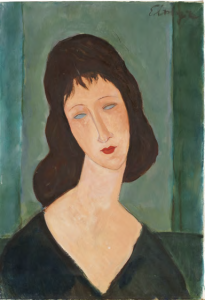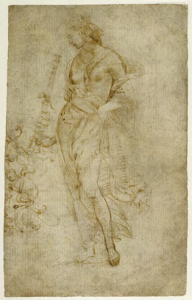Im Interview – der Autor & Kunsthistoriker Noah Charney – über Kunstfälschungen, Kunstgeschichte und über die Frage, wie ein Ausstellungstext über ihn als Kunstwerk lauten würde …
Was it a specific work of art that inspired you to study Art History?
It was not a specific work but a specific course. When I was 16 years old I was lucky enough to study abroad program organized by my boarding school, and I lived in Paris with 15 other students, living with a French family, speaking only French and studying art history in museums and churches every afternoon. Relearning in front of the works them selves, rather then in a classroom through slides, helped me to fall in love with the field of study.
As an art historian you are daily exposed to art, can art still inspire you?
All the time! The most recent example was when I went on what is called Piero trail. It is small towns in Tuscany near where Piero Della Francesca lived. There are three stops and at each one you can see at least one great work by Piero that is still in situ, rather than just placed to a museum. It is a sort of art store pilgrimage, of course with lovely Tuscan food and views. I found seeing his work in person incredibly moving.
How did you choose to become an “art-crime-investigator”?
I do not actually investigate, but I am story of our crime and I have assisted with investigations. It began when I wrote my first book, which was a big international best-selling novel called the art thief. It is available in 14 languages but for some reason not German! Doing research for that novel I realize that there was very little dog from academic perspective on the study of our crime and I turned to it from the angle as well.

Elmyr de Hory im Stil von Amedeo Modigliani: Frauenport-rät, um 1975, Öl auf Leinwand. Ein weiteres der späteren Werke de Horys, das er mit seinem eigenen Namen signierte. © Mark Forgy / Photo by Robert Fogt
Can art forgery be considered as a mere peccadillo in the public eye?
It almost always is! The media loves art forgers, and to be honest they are not particularly scary in terms of criminals and far less objectionable than most. But the world at large tends to think of them as pranksters rather than gangsters.
In your opinion, who has committed the ultimate art forgery?
Eric Hebborn is by far the most skillful, passionate, intelligent, and if we may say so admirable forger in history. I examine the stories of over 100 fortress and there are more than 60 in my book and of all of them he is the only one who I believe was an artist as skillful as the artists he forged.
Does technological development mean the end of art forgery?

Raffael zugeschrieben: Weibliche Figur mit Aulos, datiert um 1504-1509, mit brauner Tinte, 30,5 × 44,5 cm, J. Paul Getty Museum, Los Angeles; vermutete Fälschung von Eric Hebborn. © Brandstätter Verlag
Not at all. There are two sides to this. Technology means that it is much easier to forge things like works on paper, for example just using Photoshop software and a good printer. On the other hand forensic technology makes it much harder to fool testing. But as you learn in my book, one of the weird aspects about the art world is that they very rarely used forensic testing, instead of relying on expert opinion, which of course may be in error, and looking at the documented history or provenance. Most forgers are exposed through forensic testing, but the nature of the art world is such that people rarely forensically test unless they are very suspicious already. It does not have to be like that. Testing is neither invasive nor particularly expensive these days. It’s just the sociology of the art world.
What are your thoughts on the value of fake art?
It is a different category from real art. I would love to have fixed in my collection, but they can in no way compete with originals. It is more the curiosity and the story behind the crime that makes them of interest. They are rarely of extremely high quality.
Have you ever been to – The Museum of Art Fakes in Vienna?
Not yet but I would love to. I hope they invite me!
If you were a work of art, what would the exhibition label say about you?
What a great question I’ve never been asked it. Let me think. I am often described as the art to detective. This has two components to it. On the one hand of course I study crimes involving art. But on the other hand when I teach art history I teach each work of art as a Mistry, apostle or detective story that my students can try to solve. It draws them in and makes it more interactive and more of a game to learn about the works of art. So I have this detective, mystery component to my approach with her talking about true crime or art or in the case of my latest book, both.
You have written about Mona Lisa, Stealing the Mystic Lamb, art, crime, forgery and had your museums time guide made into an app, what other projects are you looking forward to starting?
I am just finishing my first cool written book, with the very famous artist Historian Ingrid Rowland. It is about Giorgio Vasari, The Renaissance artist who was also the founder of art history as we know it. The book will be called the collector of lives and comes out next year. I would also mention that I have recently started teaching about writing, more specifically the mechanics of how to make a living and get published writing books and articles. I teach short workshops that are open to anyone at University of Ljubljana and a Guardian master class in London. To learn more visit my website or join me on Facebook.
Wir danken Noah Charney herzlichst für das Interview !


Sehr spannendes Interview =) Und es gibt ein Museum mit Kunstfälschungen in Wien?! Da muss ich hin!
Ja gibt es – da musst du unbedingt hin schauen und eine Führung bei Diane Grobe (Museumsgründerin) machen – total spannend – aufregend.
Liebe Alex,
danke für das Interview – und auch für mich war das Fälschermuseum bisher völlig unbekannt! Könnt ihr das mal in einem umfangreicheren Blogbeitrag vorstellen? Wäre spannend da mehr zu erfahren…
Viele Grüße, Angelika
Liebe Angelika !
Ja leider ist das Fälschermuseum doch einigen noch unbekannt, ich war vor ewigen Zeiten (da war ich noch Tutorin für die Technische Kunstgeschichte) mit den Student_innen dort. Es war super spannend, weil Diane Grobe die Geschichten zu den Bildern mit einer Hingabe erzählt – herrlich.
Wir werden uns mit ihr rücksprechen und schauen, was uns dazu einfällt.
Liebe Grüße
Alex
Die Kommentarfunktion ist deaktiviert.